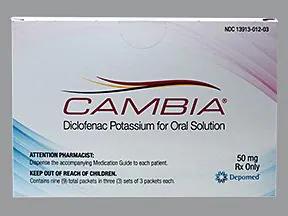Cambia Interactions
There are 453 drugs known to interact with Cambia (diclofenac), along with 11 disease interactions, and 2 alcohol/food interactions. Of the total drug interactions, 100 are major, 335 are moderate, and 18 are minor.
- View all 453 medications that may interact with Cambia
- View Cambia alcohol/food interactions (2)
- View Cambia disease interactions (11)
Most frequently checked interactions
View interaction reports for Cambia (diclofenac) and the medicines listed below.
- Aimovig (erenumab)
- amitriptyline
- baclofen
- Benadryl (diphenhydramine)
- Botox (onabotulinumtoxinA)
- clonazepam
- cyclobenzaprine
- Cymbalta (duloxetine)
- Flexeril (cyclobenzaprine)
- gabapentin
- levothyroxine
- Lyrica (pregabalin)
- magnesium oxide
- melatonin
- omeprazole
- ondansetron
- pantoprazole
- prednisone
- propranolol
- sumatriptan
- Synthroid (levothyroxine)
- tizanidine
- Topamax (topiramate)
- topiramate
- tramadol
- trazodone
- Vitamin B12 (cyanocobalamin)
- Vitamin D3 (cholecalciferol)
- Zofran (ondansetron)
- Zyrtec (cetirizine)
Cambia alcohol/food interactions
There are 2 alcohol/food interactions with Cambia (diclofenac).
Cambia disease interactions
There are 11 disease interactions with Cambia (diclofenac) which include:
- asthma
- fluid retention
- GI toxicity
- rash
- renal toxicities
- thrombosis
- porphyria
- anemia
- hepatotoxicity
- hyperkalemia
- platelet aggregation inhibition
More about Cambia (diclofenac)
- Cambia consumer information
- Compare alternatives
- Pricing & coupons
- Reviews (58)
- Drug images
- Latest FDA alerts (11)
- Side effects
- Dosage information
- During pregnancy
- Generic availability
- FDA approval history
- Drug class: Nonsteroidal anti-inflammatory drugs
- Breastfeeding
- En español
Related treatment guides
Drug Interaction Classification
| Highly clinically significant. Avoid combinations; the risk of the interaction outweighs the benefit. | |
| Moderately clinically significant. Usually avoid combinations; use it only under special circumstances. | |
| Minimally clinically significant. Minimize risk; assess risk and consider an alternative drug, take steps to circumvent the interaction risk and/or institute a monitoring plan. | |
| No interaction information available. |
See also:
Further information
Always consult your healthcare provider to ensure the information displayed on this page applies to your personal circumstances.


